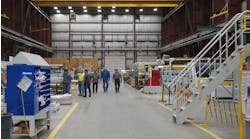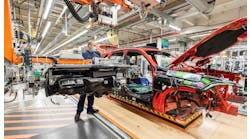So That Happened: Relief at the Panama Canal? and Explosive Book Recordings
Editor’s note: Welcome to So That Happened, our editors’ takes on things going on in the manufacturing world that deserve some extra attention. This will appear regularly in the Member’s Only section of the site.
Confidence and Investment Bright Spots
A summer slump in CEO’s attitudes and spending ahead of the November election? No chance.
That’s what the Moody’s Analytics Survey of Business Confidence appears to be suggesting. The weekly metric, which asks business leaders from around the world 10 questions about hiring and spending intentions, has improved every week but one since late March. It is nearing its level of last September—you remember that quarter, the one with GDP growth of a shade under 5%.
“Hiring and business investment remain consistent bright spots in the survey,” Moody’s Analytics Chief Economist Mark Zandi wrote this week. “Sentiment is consistent with a global economy growing near its potential.”
Another economic indicator we look to regularly also is saying good things about business investment: The latest GDPNow tracker from the Federal Reserve Bank of Atlanta has Q2 GDP growth clocking in at a solid 3.1% and says real gross private domestic investment—in equipment, buildings and inventories—is playing a big role. The latest update revised the estimate of domestic investment growth to a whopping annualized rate of 8.8% from 7.7%.
Maybe, just maybe, the long-lamented inventories glut has been worked off.
—Geert De Lombaerde
Look Who’s Talking and What’s That Rumble I Hear
John Dyer has been doing a lot of talking lately, and for good reason. Author of The Façade of Excellence: Defining a New Normal of Leadership, Dyer recently spent several full days in a small, sound-insulated room at a studio reading his book aloud in preparation for its transition into an audiobook.
“Pretty grueling” is how Dyer, an IndustryWeek contributor and IW Best Plants judge, described the experience. Interesting as well, he added.
Lots of the grueling was related to the need to remain very still while reading out loud, he said. Otherwise, the very sensitive microphone he spoke into would pick up any chair swivel or squeak, or leg shake, and he’d have to re-read portions of text. For that same reason, the air conditioning had to remain turned off in his room.
If those examples don’t adequately illustrate the sensitivity of the mike, this might: At one point, Dyer heard a rumble in the headphones he wore. That rumble turned out to be vibrations from a quarry several miles away that was doing some blasting. Those vibrations traveled through the ground and were picked up by the microphone. Pretty amazing, to this editor.
Dyer estimates it took 45 minutes to an hour to read each book chapter aloud, “depending on how many mistakes I made.” Not only could a small movement create a need to redo a portion of the text, but so, too, could a mispronounced or muffled word. A sound engineer in a separate booth worked with Dyer, following as he read aloud and alerting him to sound quality issues.
Interesting side note: Dyer had to audition to be the voice of his audiobook. Perhaps thanks in part to his disk jockey days in college, he made the cut.
Information about a release date for the audiobook wasn’t immediately available. But keep your ears peeled.
—Jill Jusko
A Comeback for the Panama Canal
If you’re a frequent IW reader, you may remember my story from last year detailing the drought conditions in Panama and resulting supply chain implications. Lower water levels led to a substantial reduction in the Panama Canal’s daily transit slots and maximum ship weights, causing a large backlog of ships, long wait times and widespread concerns about international shipping.
In 2024, the country’s rainy season and projected levels of Gatun Lake have spurred several significant updates to the canal’s capacity.
The total number of daily transits has gradually increased in recent months. According to the most recent update from the Panama Canal Authority’s Advisory to Shipping No. A-19-2024 on June 10, daily transits are set to increase to a total of 34 for booking dates from July 22 until further notice, including nine slots for Neopanamax, 19 for Supers and six for Regulars.
This brings the canal closer to 36 slots, the number of ships allowed to traverse the waterway each day in normal conditions. The maximum authorized draft for vessels has also increased to 46 feet.
Although recent conditions have alleviated pressure in the short term, it remains to be seen if shifts in weather patterns will continue to plague the canal with issues and how successful water conservation efforts will be in mitigating similar problems.
—Anna Smith
Private Wireless as Green Initiative?
I expect manufacturers to report increased productivity and OEE as the chief benefits enjoyed by deploying IoT systems. I consider private wireless networks as a supporting/enabling technology for IoT. Therefore, I expect increased productivity and OEE as the primarily KPIs as demonstrations of efficacy for wireless internet, as well.
I would not expect improved sustainability efforts as a chief benefit but that’s what Nokia says in its new 2024 Industrial Digitalization Report.
79% of the 100 responding organizations said they experienced 10% or more emissions reductions after deploying their wireless networks. To be fair, we could probably lay that on increased machine efficiency dictated by analyzing data from MES or ERP systems tied to IoT devices or native machine sensors that tie into the wireless network, in which case we’re looking at a KPI derived from OEE.
I still find this statistic interesting because it ties into the larger narrative of recognizing sustainability benefits from programs or efforts that have nothing intrinsically to do with sustainability. I’ve heard that refrain often over the past year, helping manufacturers recognize that sustainability is not a burden they must deal with to meet ESG requirements. They’re doing it already.
Energy is expensive. Decreasing power use at plants is an economic decision that also carries ESG benefits, but manufacturers may not think about it that way. Reshoring supply chain is a logistically sound decision. It also results in fewer carbon emissions by eliminating overseas transport. Again, not something one might immediately think of as generating sustainability KPIs but it sure does.
Wireless internet networks as ESG policy? Maybe I’ve been glossing over this part of the wireless pitch but I don’t think so. And it doesn’t seem outrageous, now that I think about it.
—Dennis Scimeca







